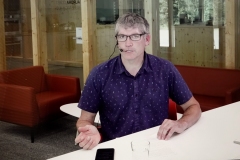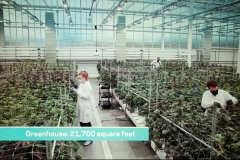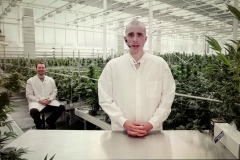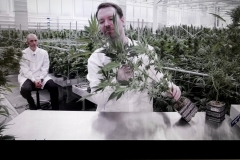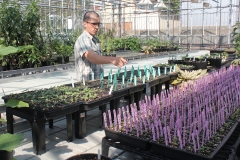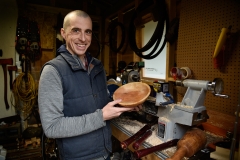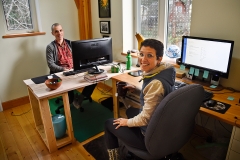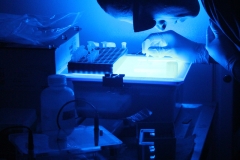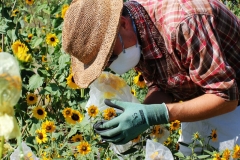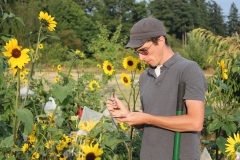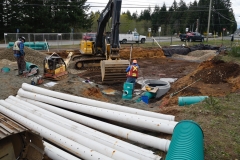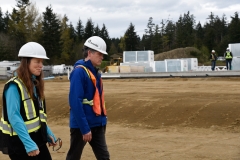These days, when he’s in a reflective mood, Jon Page looks up from the cannabis plants in his Vancouver laboratory, and wonders if he subconsciously saw it coming. “It” being the frenzied corporate rush to capitalize on Canada’s legalization of recreational cannabis that has made him wealthy.
He certainly didn’t see it coming as a young boy growing up with his twin brother, Nick, on Headquarters Road, where they dug around under logs for interesting plants to feed his as yet unrecognized drive for scientific discovery. And not even when he earned his PhD in botany at UBC in 1998.
Nor did he see it coming when he studied how chimpanzees use plants as medicine in Tanzania, or when he did post-doctoral studies of alkaloids in opium and cannabinoids in cannabis in Germany.
Page did not even see it in 2009 — consciously, at least — when he became the first scientist in the world to sequence the 30,000 genes in the cannabis genome.
He might have caught a glimpse of it when he and chemist John Coleman opened their own cannabis testing and research laboratory in 2013, called Anandia Labs, which grew under his leadership to a company valued at more than $60 million in just four years.
And it still wasn’t a clear vision in his mind when he picked Comox to construct the world’s first-ever facility focused solely on the breeding and genetics of cannabis.
But the cannabis gold-rush did come for him.
Three months ago, Edmonton-based producer Aurora Cannabis acquired Anandia for about $115 million in stock.
And yet, the excitement Page feels about legalization and his new role as Aurora’s chief science officer overseeing multiple cannabis labs around the world, is not rooted in monetary rewards. For him, legalization means he can finally pursue cannabis research without reproach or limitations.
What Aurora really acquired was Jonathan Page, PhD., Canada’s leading cannabis scientist.
In an article in BC Business magazine earlier this year, molecular geneticist Tim Hughes, a professor at the University of Toronto and Page’s co-researcher in the cannabis genome sequencing project, called Page “the man in Canada when it comes to cannabis.”
Early years in the Comox Valley
Jon and Nick Page were born in Victoria in 1969, but grew up on a large Headquarters Road property with their parents, Dave and Linda. They attended Tsolum Elementary, where Jon and a friend won an award for a science project.
Both brothers had an academic focus at Courtenay Junior and G.P. Vanier, from which they graduated in 1987. They always received top grades, and always made the honour role. Jon recorded one of the province’s top mark in Biology 12.

Jonathan Page, PhD
It was his parents’ interest in farming and growing plants that fueled Jon’s youthful exploration of the natural world, and it has stayed with him.
“We studied plants in an unfocused sort of way as kids,” Page told Decafnation. “We’d peel the bark off trees, turn over logs for mushrooms.”
One possible trigger for this interest came in the 1980s, when the Pages were 10-year-olds, and the Comox Valley had unexpectedly become the Canadian epicentre of the magic mushroom phenomena. The Headquarters Road and Tsolum River area was at the heart of the action.
“Long-hairs from Montreal and other places were camped in vans alongside most of the back roads,” Page said. “They snuck onto farmers’ fields to pick them (mushrooms). It got quite nasty.”
But the scene piqued Jon’s curiosity about why plants in their backyard were so important to people from all over the country. Since then, he’s been interested in plants used by people for a purpose, and the cultural and chemical stories behind them.
A serious focus on cannabis
After high school, Page earned a BSc degree in plant biology. As a 21-year-old undergrad, he was awarded a grant to study plant use by chimpanzees in Tanzania, and the resulting paper he published put him on the science world’s radar.
By the time Page completed a PhD in botany in 1998 at UBC, his papers had been published in several academic journals. And that helped him get a five-year National Sciences and Engineering Research Council grant to do post-doctoral studies in Germany on alkaloids in cannabis and opium.
Page returned to Canada in 2003 to run his own lab at the National Research Council’s Plant Biotechnology Institute in Saskatoon, where he worked on cannabinoid biochemistry and discovered several of the enzymes involved in producing cannabinoids like THC. The Page Lab published several seminal papers on this subject between 2008 and 2012.
Sequencing cannabis DNA
The big idea to sequence the cannabis genome came via email from a molecular biology professor at the University of Toronto that he did not yet know. Tim Hughes, who now holds the John W. Billes Chair of Medical Research, had the idea and was directed to Page as the person who could do it.

Page at his Vancouver Anandia Labs
But finding a legal place to obtain cannabis DNA proved difficult in 2009. At the NRC, Page was only allowed to study hemp. And the Saskatchewan Prairie Plant Systems, a source of plants for science, wouldn’t give him access.
Finally, a friend in Vancouver, who worked with an authorized medical marijuana patient, donated leaves from a popular strain called purple (or pink) kush, a plant known to have THC levels in the 16 percent to 18 percent range.
The sequencing took weeks and the computer analysis of that data took months, followed by more time to write the research paper, which their team published in 2011. Page had already established his reputation as a leading cannabis scientist at the NRC, but the success of the genome sequencing project put him out in front of cannabis science in Canada.
By 2013, Page had tired of the work at NRC and was frustrated with general cutbacks in research funding by the Stephen Harper government, and its refusal to support cannabis research in particular.
So Page quit the NRC, took an adjunct professor position at UBC, and teamed up with chemist John Coleman to co-found Anandia Labs in November of 2013.
“Thanks to the Harper Conservatives, I took the leap into business,” he said.
Page says Anandia — the name comes a cannabinoid called anandamide, a Sanskrit word that means “bliss” — on two pillars:
Testing — In the heady days of medical marijuana, Health Canada required producers to conduct quality assurance tests for potency, pesticide residues, toxins, moulds and other microbiological contaminants that could pose health risks for consumers.
Breeding and genetics — The pure science of discovering how a plant works in order to create improvements, such as resistance to disease and growth properties, and could generate revenue from intellectual property rights.
Comox Innovation Centre
“Where we are with cannabis today is where we were 100 years ago with tomatoes,” says Greg Baute, who, like Page, earned his PhD at UBC and will run the Comox facility as the director of breeding and genetics. “In 1918, we knew more about corn than we do about cannabis today.
“But, until now, there has been no breeding effort at the scale Jon Page has started.”

Plant Director of Breeding and Genetics Greg Baute, left, and Anandia Project Coordinator Nick Page, right, on site at the Comox Innovation Centre at Military Row and Knight Road
Baute said the facility will employ about 15 PhD- or MSc-level employees, about two-thirds of which will work on genetics and the other third on the operations and horticulture side.
The new 31,500 square-foot phase-one facility in Comox will do all of Anandia’s breeding and genetics, and provide feed stocks for more medical strains of cannabis exclusively for Aurora, but the science will ultimately benefit the whole industry.
The $20 million first phase includes a 21,000 square-foot greenhouse and a 10,500 square-foot office situated on seven acres on Military Road, near the Knight Road roundabout. Future phases will expand both the greenhouses and the labs.
For strict sanitary and disease control, there will be no public access and no public tours of the facility. Employees entering the greenhouses will have to strip down in change rooms and wear only approved uniforms to prevent introducing diseases or bugs into a tightly controlled environment.
Baute said the centre will focus on disease resistance and preventing mould, powdery mildew and other diseases and pathogens common in commercial cultivation.
The building’s plans reveal a complex network of seven independently controlled zones, each fitted with its own air scrubbers to filter out pollen and contaminants. The system is designed with ion and carbon filters to remove odour, and to not spread mildew outside the facility.
“It’s a threat,” Boute said. “Because the greenhouse provides the ideal environment for them to grow.”
Brother Nick says cannabis is an evolving new industry that, until recently, was focused on the production side.
“The science side of cannabis was missing,” Nick Page told Decafnation. “The goal of the Innovation Centre is to be a hub for cannabis science.”
Nick is the project coordinator for Anandia’s Comox facility. He is coordinating the planning, design, technical details and construction of the Comox facility. He has a masters degree in plant ecology, and works as an environmental biologist in Victoria, focused on urban ecology and integrating urban projects into ecological landscapes.
The centre will also focus on plant architecture; the size and shape of plants. It’s an unlikely, but critical area of interest.
Modern greenhouses used by licensed producers such as Aurora in Edmonton and Medicine Hat and Montreal span up to 1.5 million square feet, and use robotics to space plants as they grow larger, and move them from grow areas to processing sites. Robots maximize every square inch of grow space.
Why Comox?
Jon Page could have built his new breeding and genetics centre anywhere. In fact, he first considered the Delta and Richmond areas of the lower mainland. But when he discovered both municipalities would require zoning changes and public hearings to allow cannabis facilities, he looked elsewhere.
“Getting a development permit for warehouse space in the Lower Mainland where people are more suspicious of cannabis businesses would take way too long in the furious race to market that exists in the cannabis world,” he said.

Nick Page and Greg Baute go over building plans with their construction foreman from Heatherbrae Builders, of Nanaimo
Through Comox Valley realtor Jamie Edwards — a friend of people Page knew from growing up here — he discovered the Town of Comox had already zoned land for cannabis uses.
“Whoever in the town decided to include cannabis in the airport industrial area zoning as acceptable uses was thinking way ahead of the potential of this industry,” Nick Page said. “It was the key to bringing us here.”
Jon Page says Comox wasn’t a goal destination, just because he grew up here. But the zoning, an airport with direct flights to Vancouver, Calgary and Edmonton, the quality of life and affordable housing all factored into the decision.
Page said the ski hill, the mountain biking in Cumberland and other amenities will help Anandia Labs recruit the highly educated 20- and 30-year-olds he needs for the Comox Innovation Centre. And they are all well-paid jobs.
Centre Director Baute said he might not have accepted the position if it had been located in Vancouver.
“People don’t want to move to Vancouver anymore because the housing is expensive and the commutes are long,” Baute said.
And there was an additional positive factor in Page’s decision to pick Comox.
“More than a hometown connection, the Comox Valley is just more of a cannabis-friendly community,” Page said.
What’s next
Canada was the first country to authorize the medical use of marijuana, back in 2001. And Page was the first scientist to sequence the cannabis genome in 2011.
But despite these cutting-edge milestones, Canadian scientists were not allowed to stray far from narrowly-focused studies and enquiries than reflected current social norms. Canada is leading a lot of the medical science in cannabis, and Aurora’s labs will study that.
“Medical usage is not just stoners getting access to pot.” he said. “There are real benefits in neuropathic pain without the addictive properties of opiates, and help for anxiety, sleeplessness, MS and chronic pain.”
Legalization has changed that. It has bolted Canada to the forefront of cannabis research. It has given scientists like Page the freedom to probe the questions that its illegal status has raised but could not answer.
Did Page anticipate that would happen, or that the cannabis industry would explode at such a fast rate?
“Not consciously, but I must have seen it, or known it was important work,” he said. “I’m just a lab guy who saw an opportunity.”


